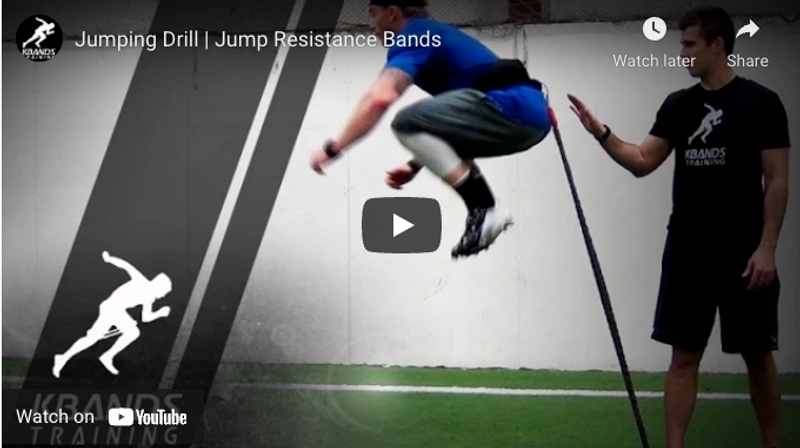Resisted Vertical Tuck Jumps
Vertical jumps are an essential and common motion on the field for a wide range of sports, and the power that gives height to a vertical jump comes primarily from the hip flexors and the core. Powerful, responsive muscle groups in these areas can health athletes learn how to jump higher and can provide the endurance they need to bounce back after they touch down. Jumping requires technique and balance, but above all, a high, controlled jump requires strength, and the best way to improve the vertical jump is through repetition and training. During the training process, the value of each rep can be magnified when athletes add the artificial resistance of the Reactive Stretch Cord.
This vertical workout, called the resisted vertical tuck jump, can help athletes learn how to jump higher and generate power in the core and hip muscles required to rise straight off the ground. The drill takes only a minute to set up and a few short minutes to execute, and it can be worked into any regular athletic training program. But this drill also requires endurance and intensity, and athletes will gain more from the session and learn how to jump higher if they invest their full energy in every single rep. Athletes and coaches can observe the video for help with the set-up.
Resisted Vertical Tuck Jumps: How to Jump Higher
The set up for this drill is very simple, and the entire exercise will require only a Kbands Reactive Stretch Cord, a small area of space in the gym or on the field, and a partner or coach to anchor the cord and provide guidance and stability during the jump.
Before beginning this vertical workout, athletes will need to warm up, stretch, and attach the Reactive Stretch Cord to the body at the level of the center of gravity. Athletes can attach the strap around the waist so it fits snuggly and doesn’t slide or shift during the jump. Then the Reactive Stretch Cord can be attached to the O ring which should be centered just above the small of the back. When the athlete jumps, the pressure of the cord should be applied directly to the center of gravity, not to the side and not too high on the torso.
When the cord is attached to the athlete, the anchoring partner can stand behind him or her and hold the stretch cord against the floor with one foot. The partner should pay close attention to the level of resistance in the cord while the athlete is standing still—the cord should not be too slack or loose, and it also should not be stretched tightly to the floor.
Too much resistance can interfere with the athlete’s jumping technique and prevent them from learning how to jump higher. The athlete should be able to touch down after the jump and immediately take off again. If the athlete needs to hesitate and recalibrate before jumping a second time, this will defeat the overload principle and undermine the value of the drill.
Resisted Vertical Tuck Jumps: Executing the Vertical Workout
As the drill begins, the athlete should jump off the ground straight into the air while executing a tuck by bending at the knees and hips. The knees should drive up and the body should rise as high as possible before the athlete lands and immediately springs back up again.
At each jump, the partner should stay mindful of the athletes body position. Since the resistance of the cord will control the direction of the jump, the athlete’s body will be pulled back toward where the partner is standing, so the partner should keep one arm up to redirect the jump, help the athlete stay stable, and prevent collisions from taking place.
In the meantime, the athlete will learn how to jump higher by keeping the knees tucked, the back straight and the arms engaged during the jump. Full height can only be attained when the arms are part of the entire motion from beginning to end. Also, the athlete will need to rise back up immediately after touching down on the ground, and each jump should involve a full measure of energy and intensity.
To maximize the benefits of the drill, athletes can complete six to eight high-intensity jumps in quick succession, followed by a rest period of a minute to a minute and a half. The rest period should last no longer than two minutes, and as it comes to an end, the athlete can jump right back into the drill for another six to eight reps.
The entire drill should involve three to four resisted sets of six to eight jumps each, broken up by short rest periods. Then the athlete can unclip the Reactive Stretch Cord from the band and complete two more reps with no resistance in place. During the unresisted section of the drill, the athlete should have plenty of space and should concentrate on gaining height by engaging the arms and tucking the knees fully at each jump.
Final Notes: How to Jump Higher Using Targeted Resistance and Focused Strength Training
When used correctly, the Reactive Stretch Cord applies targeted resistance to the core and hip areas. This added resistance can help athletes get the most out of strength-building exercises targeting the areas of the body that contribute most to specific types of motions, like vertical jumps and sprints. By adding the power of the Reactive Stretch Cord to regular strength-training and cardio-focused workout sessions, athletes can add power to these fundamental moves and see huge improvements in jumping and sprinting success on the field during sports like basketball, track and field, football, soccer, baseball, and lacrosse.

